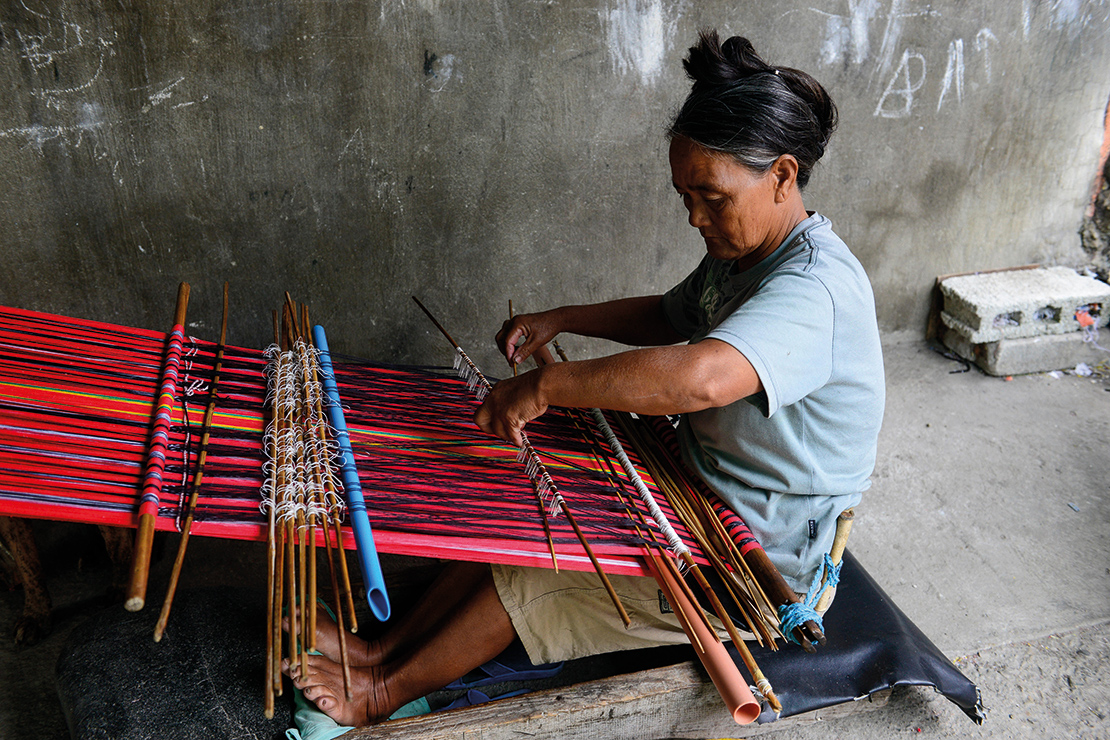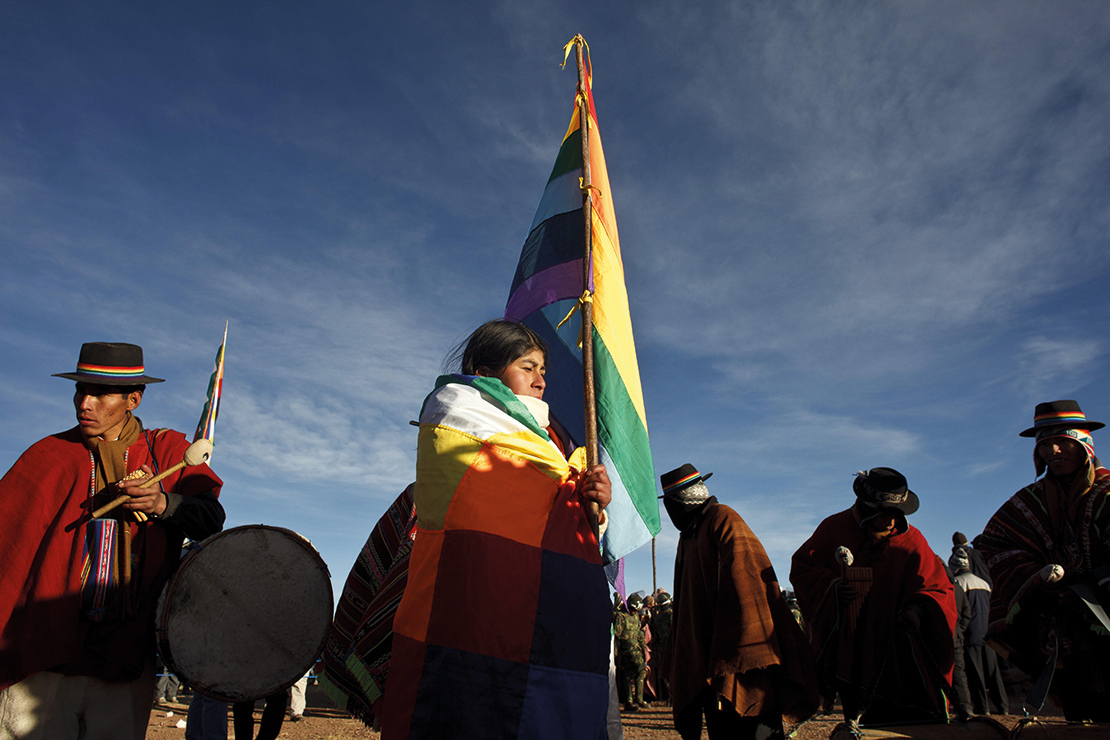Cultural transitions towards diverse ways of knowing and being
Vision
Humanity’s diverse ways of living, knowing and being in nature are celebrated, promoting plural values and worldviews across our economic, political and social systems, thereby securing the mutual resilience of nature and society. The diverse cultures of IPLCs inform and inspire the blossoming of new cultural narratives that locate humanity within a living, intelligent and sacred world.
Education for sustainable development is universal and the importance of biodiversity and cultural values are widely understood. People everywhere have relevant information, awareness and the capacity for sustainable development and lifestyles that are in harmony with nature.
Rationale
Culture is “the set of distinctive spiritual, material, intellectual and emotional features of society or a social group, and […] it encompasses, in addition to art and literature, lifestyles, ways of living together, value systems, traditions and beliefs”.
— UNESCO1
Culture conditions our behaviours and frames our relationship to others in our society and the world around us, including the natural environment. Therefore, if sustainability is first and foremost about living with nature and using the Earth’s resources in sustainable ways, then fostering diverse cultures of sustainability becomes a central strategy.
Biological diversity has co-evolved alongside humanity’s creative intelligence, manifested in cultural diversity. Today, most of the world’s remaining biodiversity is on the lands, waters and territories of indigenous peoples, a testimony to their cultures of guardianship and resilience.
But indigenous and local cultures, knowledge systems, practices and technologies are not well understood and are deprecated as static and unchanging. Prevailing values, cultural and education systems, drilled in the dominant worldview of science and technology and the mastery of nature, have been distanced from older ways of living, knowing and being in nature. Many indigenous languages, which were banned in modern schools, have been lost. Indigenous youth are educated to aspire for urban economic livelihoods and lifestyles, thus further undermining the vitality of indigenous communities. Important innovations in problem-solving by indigenous peoples are invisible or undervalued, and yet are vital cultural underpinnings of social and ecological transformation.
Contemporary societies can learn from indigenous peoples and local communities about how to be a part of the ecosystem, and how humanity can live as part of an intelligent and sacred world. New cultural narratives and visions of culture and nature working together can transform the current imbalance in human-nature relationships.
Education for sustainable development is recognised as a critical component of quality education in SDG 4: “By 2030, ensure that all learners acquire the knowledge and skills needed to promote sustainable development, including, among others, through education for sustainable development and sustainable lifestyles, human rights, gender equality, promotion of a culture of peace and non-violence, global citizenship and appreciation of cultural diversity and of culture’s contribution to sustainable development.”
Benefits of the transition
Fostering cultures of peace and co-operation within societies as well as peaceful co-existence with the natural world are important ethical dimensions of this transition. Social discrimination and inequalities embedded in contemporary worldviews, economics and politics are profoundly out-dated in today’s interdependent world. As humanity is searching for solutions to the global crises of people and planet, IPLC values, alongside other spiritual traditions, have much to contribute to addressing the underlying causes of social inequality and biodiversity loss.
Culture is also a powerful agent enriching non-formal education and lifelong learning. When educational curricula are adapted to local conditions, education becomes a key to social change and transformation. Educational initiatives to mainstream indigenous culture, languages and values in both formal and community-based education are helping indigenous students to achieve better educational results by affirming their cultural identity, building their confidence for intercultural engagement in broader society, and supporting them in learning a broader range of skills and competences.2
Dealing with rapid environmental and social change requires all sources of information and knowledge, and diverse ways of thinking, learning, adapting and transforming. Indigenous and local knowledges, together with the sciences, play critical roles in closing knowledge and technology gaps and directing the powers of innovation towards sustainable development. Combining insights and enabling exchanges across diverse knowledge systems creates richer understandings for complex problem-solving. By harnessing the powers of diversity and democracy as resources and enablers for change, it is possible to move beyond science-policy platforms towards robust knowledge-policy-society interfaces at local-global scales, thus making this a truly pan-human endeavour.3
Progress towards the transition and guiding examples
Indigenous peoples, through collective actions, are renewing their personal lives, cultures and institutions as part of broader transformations addressing 21st century crises of discrimination and social marginalisation; loss of land and biodiversity; and imbalanced relationships between people and nature. Their informed advocacy is elevating respect for indigenous peoples’ rights and valuing of indigenous cultures in contemporary global policy decisions. Indigenous peoples are reclaiming their heritage and asserting their visions of self-determined development.4 Through intergenerational learning and transmission of knowledge—including language recovery and cultural reflection among elders and youth, men and women—emergent pathways to the future are being co-created by indigenous communities both in urban and rural areas.
Among the ground-breaking advances in recent years has been the inclusion of indigenous and local knowledges alongside the sciences, as complementary systems of knowledge for achieving fuller and richer understandings of biodiversity—its values, functioning, status, trends, and the consequences of its loss at different scales. Negotiating the power differential between science and indigenous and local knowledge, and overcoming the tendency to ‘integrate’ or ‘synthesise’ indigenous and local knowledge into science, without regard for its cultural context, is a major hurdle in building balanced collaborations and partnerships.5
At the global level, IPBES has adopted an approach on working with indigenous and local knowledge, which includes: procedures for assessing nature and nature’s linkages with people; a participatory mechanism; and institutional arrangements for including IPLCs in its work. Likewise, at COP 14 Parties to the CBD adopted the Sharm El-Sheik Declaration on Nature and Culture,6 which acknowledges that “cultural elements are a fundamental part of the life and cosmological vision of indigenous peoples and local communities, who actively pursue an intrinsic and balanced relationship between Mother Nature, human-beings and the Universe.”
In Pope Francis’s 2015 encyclical on climate change and ecology,7 he reflects on the essential Catholic principle of valuing life and creation through an integral ecology addressing complex ecological and social crises, saying: “If the present ecological crisis is one small sign of the ethical, cultural and spiritual crisis of modernity, we cannot presume to heal our relationship with nature and the environment without healing all fundamental human relationships.”
Examples of initiatives to indigenise education curricula for students in the Philippines and Latin America are presented in Box 52 and Box 53 respectively.
Box 52: Partners for Indigenous Knowledge Philippines
A woman works on a loom in Bontoc. Traditional crafts like weaving are being shared with new generations through initiatives organised by Partners for Indigenous Knowledge Philippines, and other organisations. Credit: Joerg Boethling.

Case study: Indigenous peoples’ education in Filipino schools
Recent education policies in the Philippines open opportunities for teaching indigenous knowledge in schools, by recognising the right of indigenous peoples to culture-rooted education and by adopting the ‘Indigenous Peoples Education Framework’, which guides schools in localising, indigenising and enhancing the curriculum.
— Read the full case study
Box 53
A woman holds a flag representing the indigenous peoples of Latin America in Tiahuanaco, Bolivia. Credit: mauritius images GmbH.

Case study: Indigenous intercultural universities, Latin America
In Latin America, a network of indigenous intercultural universities — Universidad Indígena Intercultural (UII)8 — has been established, where indigenous students undertake post-graduate courses supportive of professional development and technical excellence in the service of indigenous peoples’ development with culture and identity. Integral to the curriculum are modules taught by indigenous women and men respected for their wisdom, expertise, leadership, cultural knowledge or spiritual guidance, speaking directly from their experiences as interlocutors for indigenous peoples’ self-determination.
— Read the full case study
Key components of the transition
Promoting education on biological and cultural diversity, sustainability, languages, human rights and heritage and integrating it into school curricula at all levels, including informal education, with a strong focus on reconnecting with nature through ‘learning by doing’ and experiencing nature. Early childhood learning, which is experiential and nature-based, has been shown to have a great impact on values in relation to the natural world.
Transmitting indigenous and local knowledge in schools, youth programmes, information and education campaigns, cultural festivals and celebrations, social media and public communications. This is important for raising broad public awareness about the linkages between biodiversity values and cultural values across society.
Having sustained dialogue between the sciences and indigenous and local knowledge systems to build a foundation for new partnerships to generate the best possible knowledge and solutions for biological and cultural resilience.
Supporting arts, literature and media which are also vital in bridging understanding between different cultures and parts of society. Through arts, literature and media, culture renews itself and its values in ways that are creative and unexpected, for each new generation. They are also among the foremost and most democratic channels through which individuals and collectives can speak to and influence society.

A bamboo box with the umbilical cord of a newborn is tied to a tree in a community forest near a village in Thailand. The tree takes care of the newborn, and no one can cut the tree down; the child becomes responsible for the welfare of the tree. Credit: Lakpa Nuri.
References
- UNESCO (n.d.) ‘Culture and Sustainable Development: the Key Ideas’. Available at: http://www.unesco.org/new/en/culture/themes/culture-and-development/the-future-we-want-the-role-of-culture/the-key-ideas/
- Dockery, A.M. (2020) ‘Inter-generational transmission of Indigenous culture and children’s wellbeing: Evidence from Australia’, International Journal of Intercultural Relations 74, pp. 80-93.
- Scientific Advisory Board of the Secretary-General of the United Nations (2016) SC/2016/UNSAB/ILK. Indigenous and local knowledge(s) and science(s) for sustainable development: policy brief by the Scientific Advisory Board of the UN Secretary-General. Scientific Advisory Board of the Secretary-General of the United Nations. Available at: https://unesdoc.unesco.org/ark:/48223/pf0000246104
- See Part 2 of this document, and Part II of Forest Peoples Programme, the International Indigenous Forum on Biodiversity and the Secretariat of the Convention on Biological Diversity (2016) Local Biodiversity Outlook: Indigenous Peoples’ and Local Communities’ Contributions to the Implementation of the Strategic Plan for Biodiversity 2011-2020. A complement to the fourth edition of the Global Biodiversity Outlook. Moreton-in-Marsh, England. Available at: https://www.cbd.int/gbo/gbo4/publication/lbo-en.pdf
- Berkes, F. (2019) ‘ILK in Environment and Sustainable Development’, presented at Indigenous and local knowledge (ILK) within IPBES assessments and beyond, part of Journées de réflexion autour de la biodiversité, INEE, CNRS, Paris (25-26 April 2019). Available at: https://biodiv-cnrs.sciencesconf.org/data/pages/ILK_notes_for_discussion_Feb_19.pdf
- Convention on Biological Diversity (2018) The Sharm El-Sheikh Declaration on Nature and Culture. CBD/COP/14/INF/46. Montreal: Convention on Biological Diversity.
- Pope Francis (2015) Encyclical Letter Laudato Si’ of the Holy Father Francis on Care for our Common Home. Vatican: The Holy See. Available at: http://www.vatican.va/content/francesco/en/encyclicals/documents/papa-francesco_20150524_enciclica-laudato-si.html
- Global Innovation Exchange (n.d.) Intercultural Indigenous University-UII. Global Innovation Exchange. Available at: http://www.stisolutions4sdgs.globalinnovationexchange.org/innovations/intercultural-indigenous-university-uii


